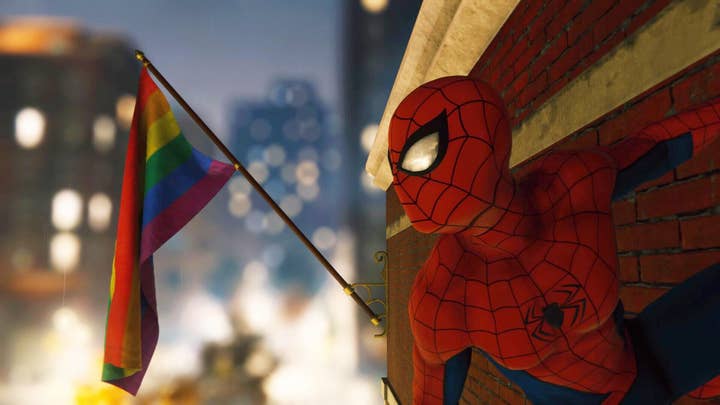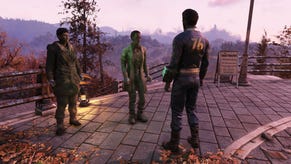Sweating the details of diversity in Marvel's Spider-Man
At Devcom 2019, Insomniac's Jason Hickey showed how small details can send a positive message in even the biggest games
For all the hype and attention that surrounds them, AAA video games are generally regarded as manufactured and impersonal. Anything that requires hundreds of hands to produce may be a masterful example of craft, but that scale and sweep comes at the expense of a little soul.
Look closely, though, and you might see the personalities of those who labour to make the industry's blockbusters shining through. At Devcom 2019, Insomniac Games' Jason Hickey proved as much with his talk on Marvel's Spider-Man, and how the streets and alleys of its virtual New York City are teeming with nods to the individual passions of its creators.
When preparing the talk, Hickey said, he was guided by one question: "What did I do that, if I wasn't there, wouldn't have gone in the game -- or maybe would have gone in a different way?"
He grouped these personal touches into three broad categories, the most intriguing of which was "history and culture." As lead environment artist, Hickey was able to scatter details throughout the map that made the space feel as diverse as its real-world counterpart, while also paying tribute to both the light and the dark of its long history.
"The history of America is in New York City. And a part of that, of course, is the very dark days before the progressive days today"
"The history of America is in New York City," he said. "And a part of that, of course, is the very dark days before the progressive days today. The slave trade started on Wall Street. Then there's the civil rights movement, LGBTQ+ rights; all of that kind of stuff happened in New York, and sent big waves across America and the world."
A movement very close to Hickey's heart is Pride, and as much as 30% of New York's Chelsea neighbourhood identifies as LGBTQ+. "It is one of the most densely populated areas in the world for Pride," Hickey said. "That is super important; this is where Stonewall happened, which is a milestone in gay rights."
Hickey discussed a way to represent Pride in the game with Insomniac's art team, and then proposed an idea to CEO Ted Price and creative director Bryan Intihar. They would create a vast mural of the iconic, rainbow coloured Pride flag and place it on a wall in the game's version of Chelsea. Capturing a photo of the Pride mural's location was one of Spider-Man's "Secret Photo Ops," so Pride "is actually part of the game."
"They were super, super supportive," Hickey said of Price and Intihar. "It's kind of sad that I felt like I had to ask, when I didn't really need to ask in the end.... I was able to do something I wanted to do, and they supported me on that. But even better, when the game came out everybody went mad for it. People were super excited."

At a time when many AAA companies are performing intellectual gymnastics to avoid admitting that their games can have important things to say, it was refreshing to see Hickey derive such clear satisfaction from transmitting a positive message through his work. A Pride mural might seem like a small flourish, but Hickey read out a player's social media post, which captured the value of its presence in the game.
"'Thinking about all of the 12 year-old kids who'll be playing this game and seeing this, in towns where it's not safe to put that flag up,'" Hickey quoted, before adding: "That was really moving for me. What seemed like an obvious thing to do may have an impact on kids' lives all over the world."
"What seemed like an obvious thing to do may have an impact on kids' lives all over the world"
Spider-Man's Pride mural was the single biggest personal touch that Hickey put into the map, but he didn't stop there. One of the game's statues is of Emmeline Pankhurst, a pivotal figurehead of the British suffragette movement who devoted her life to the pursuit and defence of women's rights. When Insomniac was making the game, not a single statue in the real Central Park depicted a woman. As Hickey pointed out, though, art doesn't have to precisely imitate life.
"In case you don't know, the amount of statues of women [versus men] in the world is lower than 5% -- it's crazy unbalanced," he said. "We didn't do a great job of moving that needle, but we will [do more] in the future."
The process was applied in both directions. One of the statues of male historical figures in Central Park depicts Dr J Marion Sims, a pioneer in the field of gynaecology, whose reputation was secure long before the disturbing details of his methods were reassessed.
"This 'doctor', this piece of work, did his gynaecological surgery experiments on slaves," Hickey said with obvious disgust. "They made a statue of him because he was 'the father of gynaecology,' but it turns out he was horrible."
The statue of Sims in the real Central Park was removed in April 2018, but Insomniac decided it had no place in its version of New York City long before that happened. There were many such decisions taken during the years Spider-Man was in development, Hickey said -- "lots of little things along the way, that made it a better version of our world."
For more of these "little things" you can look to Spider-Man's street signs. A quirk of the way the game was designed meant that New York had more streets than existed in the real city's neighbourhoods. As a result, Insomniac seized the opportunity to pay tribute to key figures in the fight for civil rights and in African American culture in general, including Malcolm X, Marcus Garvey, Frederick Douglass, and the artist Jean-Michel Basquiat.
"Not big things," Hickey told the audience. "But something."
GamesIndustry.biz is a media partner of Devcom 2019. We attended the show with assistance from the organiser.









